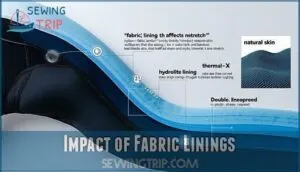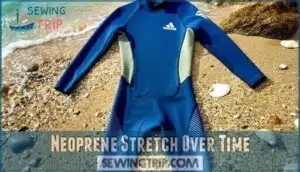This site is supported by our readers. We may earn a commission, at no cost to you, if you purchase through links.

Thicker neoprene trades stretch for insulation, while fabric linings can cut flexibility by half. Water actually helps neoprene stretch easier, acting like lubricant between rubber molecules.
Raw neoprene foam hits 480-580% stretch before breaking, but your wetsuit won’t reach those extremes thanks to protective linings. Understanding these stretch limits becomes essential when you’re choosing gear that won’t fail underwater or leave you feeling restricted during activities.
Table Of Contents
Key Takeaways
- You’ll get 200-800% stretch from neoprene, but thicker materials trade flexibility for insulation—so don’t expect your 5mm winter suit to move like a 2mm summer wetsuit.
- Your wetsuit becomes more flexible when wet since water acts as a lubricant between rubber molecules, making it easier to put on and move around underwater.
- Fabric linings cut neoprene’s natural stretch by up to 50%, so you’ll need to balance durability against flexibility when choosing between lined and unlined options.
- You can’t safely stretch neoprene that’s too tight—forcing it beyond 300% elongation causes permanent damage, so focus on proper sizing instead of trying to modify an ill-fitting suit.
Does Neoprene Stretch?
You’ll find that neoprene does stretch, thanks to its unique blend of synthetic rubber and elastane fibers that give it natural elasticity. The material can extend substantially under force while maintaining its ability to return to its original shape.
Factors like thickness and fabric linings affect how much stretch you’ll actually get.
Natural Elasticity of Neoprene
Neoprene’s built-in stretch comes from its synthetic rubber structure. This material science marvel combines flexibility with durability, making it perfect for wetsuits that move with you.
Key elastic properties of neoprene fabric:
- Contains synthetic fibers that naturally return to original shape
- Offers moderate stretch resistance while maintaining form
- Provides superstretch capabilities in thinner variations
- Balances flexibility with structural integrity for water sports
How Neoprene Responds to Force
When you apply force to neoprene, it responds predictably based on its molecular structure. The material’s tensile strength averages 27.6 MPa, meaning it withstands stress distribution well before reaching its breaking point.
| Force Type | Neoprene Response | Recovery Rate |
|---|---|---|
| Gentle Pull | Elastic stretch | 95-100% |
| Moderate Stress | Controlled deformation | 85-95% |
| Excessive Force | Material fatigue | Variable |
Understanding force resistance helps you gauge how your wetsuit will perform under pressure.
Stretch Vs. Flexibility
While neoprene reacts to force, understanding the difference between stretch and flexibility matters for your wetsuit choice. These properties work differently:
- Neoprene elasticity – how much the material extends under tension
- Material flex – how easily it bends without permanent deformation
- Flex recovery – the fabric’s ability to return to original shape
Wetsuit stretch affects fit, while flexibility influences movement comfort during water activities.
Factors Affecting Neoprene Stretch
You’ll find that neoprene’s stretch isn’t just about the rubber itself—several key factors control how much your wetsuit can actually move with you. The thickness of your neoprene, any fabric linings attached to it, and special coatings or additives all work together to determine whether you’ll feel like you’re wearing a flexible second skin or fighting against a stubborn straightjacket.
Neoprene Thickness and Flexibility
Thickness dramatically impacts your wetsuit’s flexibility. Thicker neoprene material provides exceptional insulation but sacrifices stretch—think of it as trading warmth for movement. A 5mm wetsuit won’t bend like a 2mm version.
Neoprene density increases with thickness, reducing elastic recovery and material stretch. This thickness variance affects flex life, making thinner wetsuits more responsive to your body’s movements during water activities.
Impact of Fabric Linings
Five different lining types can dramatically alter your wetsuit’s flexibility and performance. Fabric linings reduce neoprene’s natural stretch by up to 50%, affecting wetsuit fit and movement. Understanding lining materials helps you choose gear that balances durability with flexibility for your specific water activities. The choice of neoprene type, such as closed cell neoprene, is vital for ideal performance.
- Nylon-bamboo "Infinity Skin" achieves 283% elasticity – the most flexible option for unrestricted movement
- Thermal X lining reaches 217% stretch while prioritizing warmth over maximum flexibility
- Hydrolite lining provides 170% elasticity with improved water sealing at suit openings
- Double-laminated neoprene offers enhanced durability but reduces overall stretch capacity
- Smoothskin (unlined) neoprene delivers maximum flexibility but sacrifices abrasion resistance
Influence of Additives and Coatings
Manufacturers often modify base neoprene material through various additives and coatings to fine-tune stretch characteristics. These surface treatments can dramatically alter how your wetsuit performs.
Coating Types Stretch Effect Common Use
Stretch enhancers like plasticizers increase material blends’ flexibility, while reinforcing additives create targeted stiffness where needed.
How Much Can Neoprene Stretch?
You’ll find that neoprene can stretch anywhere from 200% to 800% of its original length, depending on thickness and construction.
Understanding these stretch limits helps you choose the right wetsuit thickness and avoid overstretching that could damage your gear permanently.
Typical Stretch Percentages
Raw neoprene foam delivers impressive neoprene elasticity, stretching 480-580% before breaking. However, wetsuit stretch drops substantially to 200-300% when fabric linings are added. Standard neoprene reaches 100-200% elongation, while super-stretch variants achieve 300%+.
Neoprene can stretch up to 580% in raw form, but fabric linings reduce wetsuit stretch to just 200-300%
High-end limestone and Yamamoto neoprene consistently hit maximum stretch limits, far exceeding human skin’s 60-70% capacity. The use of sustainable neoprene materials in wetsuit construction has improved overall performance and durability.
Mechanical Properties and Limits
Understanding neoprene’s mechanical limits helps you choose gear that won’t fail when you need it most. Neoprene material delivers tensile strength between 500-3,000 PSI, with impressive elastic recovery capabilities:
- Tensile Strength: Ranges from 500 to 3,000 PSI depending on formulation
- Stretch Limits: Material fatigue occurs beyond 400-800% elongation
- Durometer Range: Shore A hardness spans 20-95
- Recovery: Returns to original shape if not overstretched
- Temperature Tolerance: Maintains flexibility from -35°C to 120°C
Wetsuit stretching within these parameters ensures neoprene durability and reliable performance underwater.
Variations by Product Type
Different Wetsuit Materials create varying stretch characteristics that’ll impact your underwater experience. Neoprene Types range from basic foam to premium limestone-based variants, each offering distinct Stretch Resistance levels. Fabric Thickness and construction determine how much your gear responds to movement.
| Product Type | Stretch Range | Key Features |
|---|---|---|
| Entry-level Wetsuits | 200-300% | Basic Neoprene, moderate Product Durability |
| Premium suits | 400-500% | High-quality Neoprene Stretch, reinforced seams |
| Competition gear | 300-400% | Optimized Wetsuit Stretching, performance focus |
| Thick winter suits | 150-250% | Limited flexibility, maximum warmth |
| Thin summer suits | 350-450% | Enhanced mobility, quick-dry materials |
Does Neoprene Stretch When Wet?
When you’re suiting up for your next dive, you’ll notice that neoprene becomes more flexible and stretches easier once it gets wet.
Water acts as a lubricant between the rubber molecules, allowing the material to move more freely and conform better to your body’s shape.
Changes in Flexibility Under Water
When you submerge your wetsuit, water pressure compresses the neoprene cells, reducing flexibility by 10-15%. The material becomes stiffer underwater as neoprene density increases under pressure.
However, flexibility tests show that body heat gradually warms the material, restoring some stretch. Material fatigue doesn’t occur from normal underwater stretch, but prolonged exposure can affect long-term elasticity.
Wet Vs. Dry Stretch Performance
When you compare wet and dry neoprene stretch performance, the differences become apparent quickly. Wet neoprene demonstrates enhanced elasticity compared to its dry state, allowing greater stretch recovery without permanent material fatigue.
Your wetsuit’s dry flexibility provides baseline measurements, but wet stretch usually improves by 10-15%. This increased neoprene elasticity when submerged helps accommodate body movements during water activities.
However, repeated wetsuit stretching cycles can gradually reduce overall performance regardless of moisture conditions.
Neoprene Stretch Over Time
Your neoprene’s stretch characteristics will change as you use your wetsuit over months and years, with repeated stretching gradually reducing its ability to snap back to original dimensions. You’ll notice permanent stretching in high-stress areas like knees and shoulders, while temporary stretching from normal use usually recovers within hours of drying.
Effects of Repeated Use
Repeated stretching cycles gradually weaken neoprene’s molecular structure, leading to permanent elasticity loss. Your wetsuit won’t bounce back like it used to after countless surf sessions.
Key signs of neoprene fatigue include:
- Loose fit in previously snug areas
- Visible wear patterns at stress points
- Reduced stretch recovery after use
- Material thinning at joint areas
Regular use creates micro-tears that accumulate over time, compromising the wetsuit’s original stretch properties and insulation performance.
Permanent Vs. Temporary Stretch
Understanding whether neoprene stretch is permanent or temporary helps you make smarter wetsuit decisions. Most neoprene stretches up to 300% without permanent deformation, but overstretching causes lasting damage.
| Stretch Type | Recovery | Duration |
|---|---|---|
| Temporary | Full return to original size | Minutes to hours |
| Permanent | Partial or no recovery | Indefinite |
When wet, neoprene becomes more pliable, creating temporary stretch that reverses upon drying. However, exceeding elastic recovery limits through neoprene fatigue leads to material degradation and permanent deformation that compromises wetsuit stretch performance and flex life.
Signs of Wear and Degradation
Your neoprene wetsuit won’t last forever. Like a trusted friend showing signs of age, deteriorating neoprene reveals telltale warnings that it’s time for replacement or retirement.
- Fabric Fading – Colors become dull or patchy from UV exposure
- Material Cracking – Small tears or splits appear in high-stress areas
- Seam Failure – Stitching separates or adhesive bonds weaken
- Elasticity Loss – Neoprene won’t return to original shape after stretching
- Surface Roughening – Smooth texture becomes bumpy or brittle
These signs indicate neoprene deterioration that compromises wetsuit performance and warmth.
Getting The Right Wetsuit Fit
You’ll want a snug wetsuit fit that feels like a second skin, but not so tight that it restricts your movement or breathing.
Understanding how neoprene’s stretch properties affect sizing helps you choose the right wetsuit that’ll perform well and last longer in the water.
Importance of a Snug Fit
Without proper wetsuit fit, you’ll sacrifice performance and comfort. Neoprene needs snug contact with your skin to trap warming water layers effectively. Too loose means cold water flushes through, defeating insulation. Too tight restricts movement and circulation.
| Fit Quality | Water Exchange | Performance Impact |
|---|---|---|
| Perfect Snug | Minimal flush | Maximum warmth |
| Too Loose | Constant flow | Heat loss |
| Too Tight | Restricted circulation | Discomfort |
Your wetsuit should feel like a second skin.
How Stretch Affects Sizing
Neoprene’s stretch directly impacts wetsuit sizing decisions. Size charts account for fabric elasticity, but you’ll need a tighter initial fit than regular clothing.
Thicker neoprene offers less stretch, requiring more precise sizing considerations. Fabric choice matters—lined neoprene stretches less than unlined versions.
Remember, wetsuits should feel snug when dry since neoprene stretch accommodates body movement underwater.
What to Do if Fit is Not Ideal
Several options exist when your wetsuit doesn’t fit properly. Don’t let poor fit ruin your water adventures—neoprene’s stretch has limits, and forcing an ill-fitting suit can damage the material.
Consider these solutions:
- Professional wetsuit alterations can adjust length and width within neoprene’s stretch compensation range
- Check sizing charts again—you might need a different size entirely
- Try fabric modifications like adding panels for better fit adjustments
- Exchange or return if still within warranty—proper wetsuit fit is essential for performance
Remember, a good fit should feel snug but not restrictive.
Caring for Stretch and Longevity
You’ll extend your wetsuit’s stretch and lifespan by following proper care techniques that protect neoprene’s elastic properties from degradation.
Simple maintenance habits like rinsing with cold water, avoiding harsh chemicals, and proper storage can prevent your gear from losing flexibility and turning into an expensive rubber straightjacket.
Best Cleaning and Maintenance Practices
Three simple steps keep your wetsuit stretchy and strong. First, rinse with cold water after each use to remove salt and debris. Hand wash monthly using gentle detergent designed for neoprene cleaning.
Second, hang properly—never fold wet neoprene, which creates permanent creases.
Preventing Loss of Elasticity
Beyond proper cleaning, protecting your wetsuit’s elasticity requires smart handling habits. Heat, chemicals, and UV rays are neoprene’s biggest enemies. Your wetsuit’s stretch resistance depends on how well you shield it from these threats.
Key neoprene preservation strategies:
- Avoid petroleum-based products like sunscreen or oils
- Keep away from chlorinated pools when possible
- Rinse immediately after saltwater exposure
- Never leave in hot cars or direct sunlight
These durability enhancement steps maintain your wetsuit’s material reinforcement and prevent premature aging.
Storing Wetsuits for Maximum Lifespan
Proper wetsuit storage keeps your neoprene material performing like new for years. Hanging methods work best – use wide hangers to distribute weight evenly and prevent creasing. Avoid folded storage, which creates permanent bends that reduce stretch.
Keep your wetsuit away from direct sunlight and heat sources during dryer maintenance. Store in cool, dry spaces for ideal neoprene preservation.
Frequently Asked Questions (FAQs)
Does neoprene stretch in the same way in all directions?
Neoprene’s stretch varies by direction—you’ll find 50% more elasticity lengthwise than widthwise due to fiber orientation. This directional difference affects how your wetsuit fits and moves with you.
Does neoprene stretch more when it is new or when it is old?
New neoprene stretches more easily than old material. **Fresh neoprene has maximum elasticity and flexibility.
**
Over time, exposure to saltwater, sunlight, and repeated stretching reduces its ability to expand and contract smoothly.
Does neoprene stretch more when it is wet or when it is dry?
When wet, you’ll find neoprene becomes more pliable and stretches easier than when dry.
The water acts like a lubricant, allowing the material’s molecules to move more freely and accommodate stretching forces.
How much stretch is too much stretch for neoprene?
While some think any stretch damages neoprene, you’ll know it’s excessive when permanent deformation occurs. Beyond 300% elongation, neoprene loses recovery ability and won’t return to its original shape, compromising your wetsuit’s fit and thermal protection.
What can I do to stretch neoprene if it is too tight?
You can’t safely stretch neoprene once it’s manufactured. Instead, try wearing it wet, using lubricant during entry, or consider professional alterations. Forcing tight neoprene risks tearing the material permanently.
Can neoprene tear from excessive stretching?
Picture a surfer forcing their wetsuit over muscular shoulders—push too hard and you’ll hear that telltale rip.
Yes, neoprene can tear from excessive stretching, especially when you exceed its maximum tensile strength of 6 MPa, causing permanent damage.
Does neoprene shrink back after stretching?
Yes, neoprene does shrink back after stretching thanks to its elastic properties. You’ll find it recovers well from moderate stretching, returning close to its original dimensions when the stress is removed.
Which neoprene brands offer best stretch?
You’ll find top stretch in Rip Curl’s E7 neoprene, known for its super-stretchy properties. Xcel wetsuits are the all-round top pick for flexibility.
Yamamoto 44+ neoprene delivers maximum stretch for triathlon suits. Patagonia and O’Neill also rank high for cold-water performance.
How does temperature affect neoprene stretch?
Temperature dramatically affects neoprene’s stretch. Cold water makes it stiffer and less flexible, while warm conditions increase elasticity.
**You’ll notice your wetsuit feels tighter in frigid water but more pliable on sunny days.
Is stretched neoprene weaker than unstretched?
Stretched neoprene loses about 10-15% of its tensile strength compared to unstretched material. You’ll notice reduced tear resistance and faster wear when your wetsuit’s constantly under tension.
Conclusion
Understanding neoprene’s exceptional elasticity transforms how you’ll approach gear selection and maintenance. Does neoprene stretch? Absolutely—with proper care, you’ll optimize its 200-800% extension potential while preserving structural integrity.
Thickness, linings, and environmental conditions all influence performance. Whether you’re diving deep or surfing waves, respecting neoprene’s natural limits ensures your equipment remains reliable when adventure calls. Smart maintenance practices keep that essential stretch working for years ahead.
















